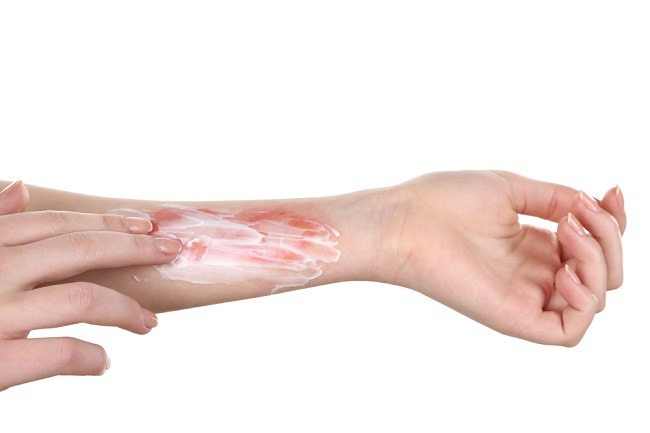Burns is one of the health problems in modern society related to tissue damage. Burns are difficult to heal and affect sufferers, both physically and psychologically. This study was conducted to evaluate the potential for administration of epigallocatechin gallate (egcg) ointment to the healing process of degree 2 burns on the skin of white rats (rattus norvegicus).
Twenty-five white rats were divided into five treatment groups. Group P0 is a group of mice that suffered burns and were given cream-based therapy (PEG). Group P1 is a group of mice that suffered burns and were given standard therapy with silver sulfadiazine. P2, P3, and P4 groups are groups of mice who suffered burns and were treated with EGCG ointments with concentrations of 1%, 2%, and 4%, respectively. At the end of the study, excision of the skin tissue was made for the preparation of histopathological preparations using Hematoxyline Eosin staining.
Histopathological preparations were evaluated for collagen deposition, PMN infiltration, angiogenesis, and reepithelialization. The results of the study in group P4 showed the highest process of re-epithelialization and collagen formation, accompanied by a marked decrease in the inflammatory process and angiogenesis. This condition is significantly different from the groups P0, P1, P2, and P3.
Healing second-degree burns with 4% EGCG is better than other treatment groups because the compounds contained in it have antioxidant, anti-inflammatory, and antibacterial activities. The three activities owned will synergize in the process of wound healing. Provision of 4% EGCG ointment for 14 days for second-degree burns can accelerate the wound healing process which is characterized by improved re-epithelialization, collagen deposition, PMN infiltration in the wound area, and angiogenesis.
Healing and repairing tissue in burns is considered a complex process that involves inflammation, granulation tissue formation, and tissue repair. Oxidative stress plays an important role in delaying healing of burns and contributes to poor healing outcomes.
Treatment with anti-inflammatory, antioxidant, and antibacterial properties can strengthen cellular antioxidant defense mechanisms, can reduce tissue damage mediated by free radicals, minimize tissue damage during the healing process of burns and can accelerate the process of wound healing.
Epigallocatechin-3-gallate (EGCG) is the main polyphenol compound in green tea and is thought to contribute to the repair process of burns and scars. Epigallocatechin-3-gallate has a potential effect on wound contraction during the wound healing process. Epigallocatechin-3-gallate inhibits factor-kβ and activator protein 1 in skin fibroblasts. Besides, EGCG has the activity of modifying the transformation growth factor β (TGF-β) which suppresses the TGF-β receptor. It will reduce the expression of matrix metalloproteinase-2 (MMP-2) and MMP-1.
Matrix metalloproteinase-2 is an enzyme that functions to degrade the extracellular matrix, and its increase is associated with impaired wound healing processes. Epigallocatechin-3-gallate can reduce the regulation of type 1 collagen synthesis. All of these mechanisms make EGCG a potential anti-scarring factor in the wound healing process, including burns.
Epicatechin, Epicatechin gallate, Epigallocatechin, and Epigallocatechin gallate are key compounds that have antioxidant activity and are proven to increase collagen volume during the wound healing process. Epigallocatechin gallate has also been used as an agent to stimulate keratinocyte formation. Besides, its anti-fibrogenic activity has also been confirmed in several animal research models.
The beneficial effect of the use of EGCG is a good wound healing quality because it has the effect of increasing blood vessel endothelial growth, accelerating blood vessel formation, and increasing nitric oxide and cyclooxygenase. The presence of blood vessels in the area around the wound can help the distribution of nutrients into cells and contribute to the acceleration of the wound healing process.
Epigalocatechin gallate is thought to be an expressive agent for the connective tissue growth factor gene and a regulator of inhibition of collagen gene expression. Other activities affecting the production and differentiation of myofibroblasts, growth of connective tissue, and classification of collagen regulation have been proven. Significant improvements in re-epithelialization, collagen deposition, inflammation, and angiogenesis occurred with 4% ointment. EGCG has the potential to be developed into therapeutic products for the treatment of burns. (*)
Writer: Wiwik Misaco Yuniarti and Bambang Sektiari Lukiswanto
Detail information from this research can be seen in our writing at
http://ojs.unud.ac.id/index.php/jvet. DOI : 10.19087/jveteriner.2019.20.1.1
Wiwik Misaco Yuniarti dan Bambang sektiari Lukiswanto. 2019. Potensi Salep Epigallocatechin gallate terhadap Proses Kesembuhan Luka Bakar Derajat II pada Kulit Tikus Putih. Jurnal Veteriner, 1(1):1-7. (Edisi Maret 2019)





